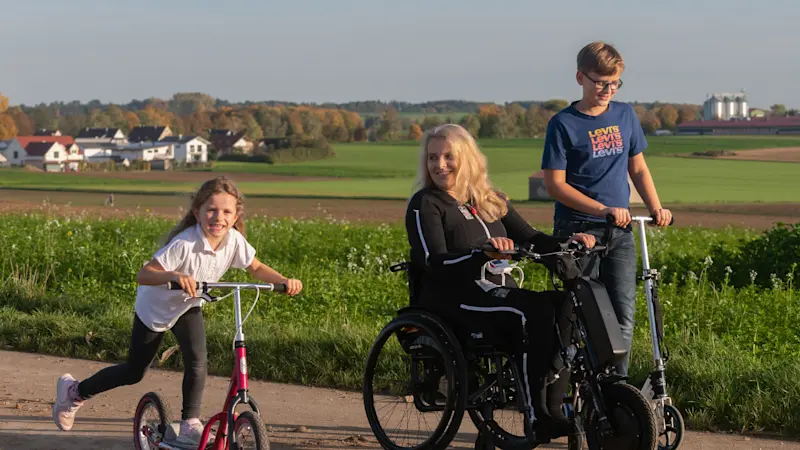Innovation for MS patients: a superhero suit with 58 electrodes gives a severely disabled mother her life back
Kerstin’s story as a patient – neuromodulation suitfor advanced multiple sclerosis

Wednesday, 11 January 2023
Kerstin was diagnosed with multiple sclerosis at the age of 17. Her condition deteriorated dramatically over the years, leading her to become dependent on a wheelchair from late 2021. The pain caused by spasticity was a constant in her life and required her to take as many as 30 pills and medical anaesthetic substances every day. A trained nursery school teacher, Kerstin is one of more than 120,000 people in Germany with multiple sclerosis (1) – the most common neurological disorder that leads to permanent disability in young adulthood. The condition primarily affects women, who are twice as likely as men to develop it (2). Around 75 percent of those affected experience a type of MS known as relapsing-remitting, especially in the early stages of their condition (3). There is currently no cure for MS and conventional drug therapies focus mainly on reducing the frequency of relapses. But what happens after the relapse period, when the condition has progressed to such an extent that it can no longer be effectively treated?
Now 40 and a mother of two, Kerstin discovered a neuromodulation suit equipped with 58 electrodes while browsing Instagram. Developed in Sweden, the Exopulse Mollii Suit is a world first and works on the principle of reciprocal inhibition for spasticity-related muscle tension. In doing so, the suit helps individuals by gently providing targeted, quick and sustained relief. Today, Kerstin uses her Instagram platform to share insights into the effects of the suit and give hope to others with similar conditions.
Life in paralysis: pain, social isolation and lack of accessibility
When Kerstin was diagnosed with multiple sclerosis as an adolescent, the first thing she felt was relief – because her symptoms finally had a name. In people with MS, the insulating layer (myelin) that surrounds the nerve fibres is irreversibly damaged due to as yet unexplained causes. The most common symptoms include motor disorders, fatigue and paralysis of the limbs. As a result, certain muscles are continuously tensed, then harden, become stiff and impair everyday movements. Gradually over time, the disease has a literally paralysing effect on the person’s entire life. “MS has always restricted what I can do, every second of my life. I wasn’t able to breathe or move freely. And the biggest obstacle of all has actually been the environment around me”, says Kerstin, describing the impact of the condition on her everyday life.
In November 2021, she began using a wheelchair on a permanent basis – and while she does fundamentally appreciate its role as a device in her life, there is also an acknowledgement that the body is not designed to spend hours sitting in the same position. Added to this is the feeling that wheelchair users can experience of being unnoticed when they are only half the size of everyone else and simply pushed to the side. “The wheelchair itself isn’t a huge deal. It’s the environment that causes the main issue, especially where I live far out in the country, in a village of three hundred people. I’m pretty much the only wheelchair user people ever see when they venture beyond their own four walls. So my surroundings are really the biggest hurdle: there aren’t any schools, nurseries, venues, doctor’s surgeries or therapists with accessibility provisions.” Despite Kerstin’s highly sociable nature, this situation increasingly led her to feel excluded from society and from having a social life. She was unable to attend her son’s school concerts or take her daughter to nursery, and she had to miss out on friends’ birthdays.
The spasticity and the pain associated with it became her constant companion and left her confined to her own home. “I was just existing. I was alive, but I wasn’t really living”, says Kerstin, describing this period of her illness. “Of course, the way things have developed over the past few years has been completely horrific for my children. My son knows what it was like when I was able to move about, stand, walk and work. My daughter doesn’t remember that, and for her it’s been an absolute nightmare.” The former nursery school teacher was taking up to 30 pills a day: although designed to provide her with some relief, they were also surrounding her in a fog. Despite all this, the pain persisted and Kerstin was unable to sleep for more than half an hour at a time. Her physiotherapy became merely palliative and she began living from day to day without imagining any sort of future for herself.
A new quality of life thanks to 58 electrodes – found on Instagram
Kerstin then stumbled upon an unexpected glimmer of hope in the form of a neuromodulation suit she discovered on the social media platform Instagram. While scrolling, she had her attention caught by a video of a young woman also experiencing MS. The suit had allowed this person to walk again, write, hold a glass of water and experience significantly less spasticity – meaning less pain as well. “There’s no way that’s real”, was Kerstin’s first thought – but with her curiosity aroused and a hint of hope appearing, she contacted the woman on Instagram anyway and became keen to test the suit on herself. With her stiff muscles preventing her from even sitting in a car to drive to the medical supply company however, an O&P professional made an exception and came to her home so that she could test the suit.
“There is no comparable product on the market. The Exopulse Mollii Suit is unique. Every single time, it’s simply amazing to see the way in which the suit helps users. For some people it makes the little everyday things possible again, and for others it essentially gives them back the ability to walk”, says Daniel Hublitz, Head of Market Management NeuroMobility at Ottobock Germany, talking about the innovative medical device developed by Fredrik Lundqvist, a chiropractor and electrostimulation expert from Sweden. With 58 embedded electrodes, the neuromodulation suit stimulates muscles affected by spasticity, making it the first suit in the world to use a physiological reflex mechanism: in this, an electrical signal sent to an antagonistic muscle relaxes the spastic muscle. When the biceps tense-up, for example, the Exopulse Mollii Suit stimulates the triceps to relax the biceps. This releases spastic muscles, activates (or reactivates) weak muscles and reduces spasticity-related pain with additional positive results: mobility, range of motion, balance and blood circulation are all improved. Kerstin wears the Exopulse Mollii Suit every day for 60 minutes. Just this one hour is enough to maintain its positive impact throughout the day. The process is non-invasive and non-pharmacological, and thus has a significantly lower probability of side effects compared to conventional treatments for spasticity. The “superhero suit”, as it has been nicknamed by many patients, consists of a jacket and pants with a battery-powered and removable control unit, and is suitable for people with neurological movement disorders such as cerebral palsy, stroke or – as in Kerstin’s case – multiple sclerosis.
A lifesaver for Kerstin: 60 minutes make all the difference
When Kerstin recalls wearing the suit for the first time, she becomes emotional: “In the lead-up to getting the suit, I felt the same kind of nervous excitement that I did before my children were born – it was my last remaining hope. Finally, the day arrived and within ten minutes of putting it on, I felt something happening in my body. And after an hour, I knew there was no way I was handing it back.” Just 60 minutes made all the difference to Kerstin’s life. Her physiotherapist is also thrilled about the impact the suit has had on her and how she has progressed, and has once again started developing specific therapy goals with her that go beyond maintaining mobility and merely relieving pain.
Initial clinical studies have confirmed that patients experiencing cerebral palsy, multiple sclerosis and the effects of a stroke reported an improved feeling of balance after only 60 minutes in the Exopulse Mollii Suit, and their risk of falling was reduced. Regular use every other day also helped them maintain their improvement. One of the preliminary studies also showed that one hour of wearing a suit resulted in significant relief of pain symptoms in patients who had reported them. Four weeks later, patients who had used the suit regularly were experiencing sustained pain relief thanks to a carry-over effect. (4)”Some of the feedback from our users has been just phenomenal. The effects of using the suit vary widely from person to person, depending on their diagnosis”, says Daniel Hublitz in summary.
When Kerstin is asked what has changed for her, she answers: “Everything. I feel like I can participate in life again – my strength is a thousand times better than it was before. I can cook, do housework, put on socks, write and make phone calls. I can breathe freely again without the spasticity constantly enclosing me and taking away my ability to draw in air. It’s simply unimaginable. What’s most important for me, of course, is that I feel like I can give everything to being a mum to my children again. The suit has truly given me my life back”. Since this breakthrough, Kerstin has stopped taking all but one of her medications and has been able to go to Italy on holiday with her family. She even has thoughts of returning to work as a nursery school teacher one day. In the meantime, she’s working hard on spreading the word about the suit on Instagram. Almost every day, she is in touch with other individuals with similar conditions and their families, and she shares her experiences with them: “Now, people like me who had previously run out of hope and treatment options can see a light in the darkness”. Kerstin’s new superpower? The feeling of finally having a future again.
Gold, R: Diagnose und Therapie der Multiplen Sklerose: Leitlinien für Diagnostik und Therapie in der Neurologie (AWMF register number 030/050), 2014. The ten most common neurological diseases – Deutsche Gesellschaft für Neurologie e. V. (German Society of Neurology; dgn.org)
Ottobock brochure: My life with MS. Mobility for people with multiple sclerosis. P. 4.
Exopulse Registry Clinical Research Report; data on file
2 results out of 2

